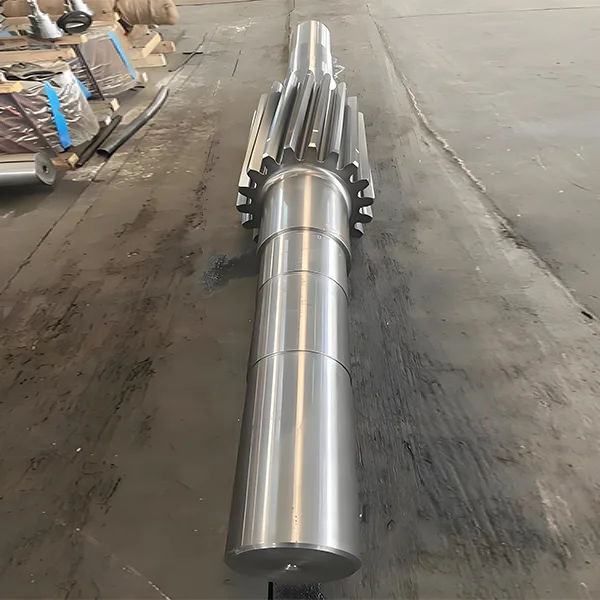Gear shafts are fundamental components in mechanical systems, transmitting torque and rotational motion between gears and ensuring smooth operation of machinery. Selecting the right gear shaft is critical for system efficiency, longevity, and reliability. A poorly chosen gear shaft can lead to excessive wear, misalignment, vibration, or even catastrophic failure. Understanding the factors that influence gear shaft selection can help engineers, manufacturers, and maintenance professionals make informed decisions.
Sawei Equipment Technology specializes in developing complete process equipment solutions, primarily serving the agricultural chemical sector (including phosphorus chemical, sulfur chemical, ammonium phosphate, and compound fertilizer projects) and the bio-fermentation industry (covering industrial waste gas, waste oil recovery, and environmental recycling projects). Their expertise ensures that high-quality mechanical components, including gear shafts, meet the demands of complex industrial applications.

1. Understand the Mechanical Requirements
Before selecting a gear shaft, it is essential to evaluate the mechanical demands of your system:
-
Torque requirements: Determine the maximum torque the shaft must transmit without failure.
-
Speed and rotational direction: Consider operating RPM and whether the shaft will experience reverse rotation or oscillation.
-
Load type: Identify whether the shaft will be subjected to radial, axial, or combined loads.
-
Gear type: Be aware of the mating gears (spur, helical, bevel, or worm), as different gears impose distinct stress patterns on the shaft.
Sawei Equipment Technology designs gear shafts that can handle high-performance loads typical in fertilizer processing, chemical plants, and bio-fermentation equipment, ensuring reliability under demanding operating conditions.
2. Material Selection
Material choice plays a crucial role in the strength, durability, and wear resistance of a gear shaft. Common materials include:
-
Alloy steels: High strength, toughness, and fatigue resistance, ideal for industrial applications.
-
Stainless steels: Resistant to corrosion and suitable for environments with moisture or chemicals.
-
Carbon steels: Economical option for moderate loads and standard industrial applications.
Surface treatments like case hardening, nitriding, or induction hardening can further enhance wear resistance and service life, which is particularly important in heavy-duty fertilizer and chemical processing machinery.
3. Dimensional and Geometric Considerations
Proper shaft sizing ensures efficient torque transmission and minimizes mechanical stress:
-
Diameter and length: Must be sufficient to withstand bending and torsional loads.
-
Keyways and splines: Allow secure connection to gears and other components, but must be designed to avoid stress concentration.
-
Tolerances and surface finish: Critical for smooth assembly, gear alignment, and minimizing vibration.
Sawei’s expertise in precision manufacturing ensures that gear shafts are fabricated with tight tolerances and robust geometries suitable for industrial-scale equipment.
4. Load Capacity and Safety Factors
Gear shafts must be designed to handle both continuous operational loads and occasional peak loads. Engineers typically apply a safety factor to account for material variability, dynamic forces, and unexpected overloads.
Consider:
-
Fatigue life: Evaluate cyclic stress and potential failure modes.
-
Deflection limits: Ensure the shaft maintains alignment under load.
-
Vibration and resonance: Avoid operating frequencies that can induce harmful vibration.
Sawei Equipment Technology integrates these factors into their gear shaft design, ensuring long-term reliability in harsh chemical and fermentation environments.
5. Environmental and Operational Conditions
The working environment influences material choice, coatings, and maintenance schedules:
-
Temperature: High or low operating temperatures may require specialized alloys or heat treatments.
-
Chemical exposure: Corrosive atmospheres necessitate stainless steel or protective coatings.
-
Moisture and dust: May require seals or protective covers to prevent contamination.
Sawei’s experience in agrochemical and bio-fermentation industries ensures that shafts are designed to withstand aggressive environments, from corrosive gases to high-humidity conditions.
6. Maintenance and Serviceability
Selecting a gear shaft that is easy to maintain reduces downtime and increases equipment longevity:
-
Replaceable bearings and couplings for efficient servicing.
-
Modular designs allow quick shaft replacement without disassembling the entire machine.
-
Monitoring points for wear, lubrication, and alignment checks.
Sawei Equipment Technology provides solutions where maintenance efficiency is integrated into the design, reducing operational interruptions in complex process equipment.
Conclusion
Choosing the right gear shaft is a balance of mechanical requirements, material selection, dimensional accuracy, load capacity, environmental conditions, and maintainability. In industrial applications such as fertilizer production, chemical processing, and bio-fermentation, a properly designed shaft ensures operational efficiency, safety, and longevity.
Sawei Equipment Technology leverages its expertise in complete process equipment development to provide precision-engineered gear shafts that meet the rigorous demands of modern industrial systems. Their solutions ensure that your machinery operates reliably, efficiently, and safely, even in the most challenging operational environments.
www.swasps.com
Jiangsu Sawei Equipment Technology Co., Ltd.
About Author
You may also like
-
How Does a Balloon Catheter for Urethral Dilatation Support Minimally Invasive Urology?
-
Permanent Magnet Coupling with Brake Wheel: Achieving Soft Start and Emergency Braking in Large Fan Systems
-
How Connector M23 Enhances Efficiency and Safety in Automation Systems
-
Why Choosing the Right Crucible Is Crucial for High-Precision Metal Casting and Laboratory Work
-
Why Electrolytic Ultrasonic Mold Cleaning Machines Are Revolutionizing Precision Mold Maintenance
